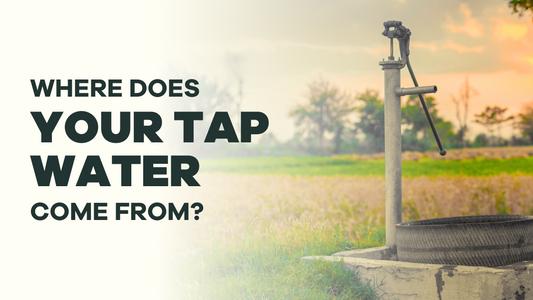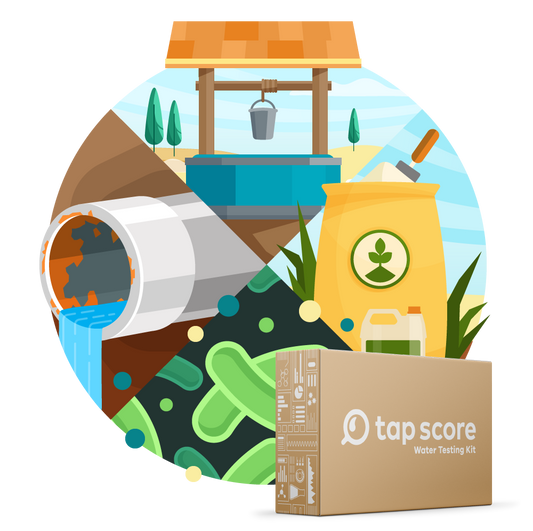
How Does the Tap Score Algorithm Work?
Our blog is written by real experts— not AI. Each guide is carefully reviewed and updated based on the latest research. Plus, with no affiliate links, you can count on unbiased insights you can trust.
Because water quality is indispensable to healthy living, a simple way of understanding tap water is vital to our well-being. The environment, the infrastructure, and the plumbing of your home can all have major effects on the water you drink, cook with, and bathe in.
Enter Tap Score. Developed by SimpleLab, the Tap Score algorithm evaluates the potential health, aesthetic, and plumbing effects of your lab-submitted water sample, providing a rigorous yet clear picture of your water quality in language anyone can understand. In the following guide, you’ll learn all about the Tap Score algorithm.
Table of Contents:
What Is a Tap Score?
Tap Score is a water quality score designed to give you a straightforward analysis of your water.
- Tap Scores range from 1 to 99
- A score of 1 is the worst outcome
- A score of 99 is the best possible outcome
How Is a Tap Score Calculated?
Every Tap Score is a weighted average, or composite, of three subscores. The subscores represent three categories that are important to understanding your drinking water
- Health: how your drinking water impacts your body over time
- Aesthetic: the noticeable characteristics of your water (e.g. taste, smell, color)
- Pipe: the effects of your water on your plumbing, pipes, and fixtures
In order to calculate these subscores, the Tap Score algorithm uses an expert curated database of hundreds of parameters (water quality contaminants and properties) and their benchmarks (thresholds of acceptability for each parameter). The algorithm is designed to analyze and assess as many parameters as possible.
Here’s how it works:
- Your water sample is sent to the lab for testing.
- The results of your lab report are run through the Tap Score algorithm.
- The Tap Score algorithm sorts each test result into one (or more) of three categories: health, aesthetic, and pipe.
- The algorithm then assigns each result a parameter score. Because a single parameter can be relevant to health, aesthetics, and/or plumbing, each result may have up to three parameter scores.
- The Tap Score algorithm calculates three aggregate health, aesthetic, and pipe scores, known as “subscores,” from the parameter scores calculated in the previous step.
- Finally, the three subscores are weighted and averaged—with a priority weight given to potential health risks—into a final Tap Score.
Diving Deeper
Getting from a sample of tap water to a Tap Score takes quite a bit of mathematical ingenuity. In this section, we’ll take a closer look at the components that are integral to the algorithm’s operations. From there, we’ll describe the scoring process to the final Tap Score.
What Is a Parameter?
The term “parameter” is a broad one. A parameter is any of the following: chemical contaminants, microbes, radiological species, physical characteristics, or observable features. Some parameters are measured in units of concentration, others are measured in standard units, such as the log-scale of pH.
What Is a Benchmark?
We can best understand benchmarks by their relationship to parameters. In a particular water sample, benchmarks help us determine whether a parameter is too high or too low. Benchmarks for a parameter can be specific to the parameter’s health aesthetic, or pipe impacts.
Additionally, benchmarks allow us to standardize lab results that may vary widely in terms of their values and units. The benchmarks used in the Tap Score algorithm are gathered from expert sources [1] and authoritative agencies.
What Is a Parameter Score?
Tap Score separates the parameter results in a water sample into three individual categories to calculate parameter scores, which evaluate how drinking water might impact your health, the way you experience your water, and your plumbing infrastructure. A single parameter can be scored in any or all of the three categories:
-
Health: Parameters that get scored in the health category represent various classes of contaminants that impact health and can include microbial contaminants (e.g. bacteria and other pathogens), inorganics (e.g. nitrate, arsenic, fluoride, and trace metals), organics (e.g. disinfection by-products, pesticides, and PFAS), and radiological species (e.g. uranium, radon, gross alpha/beta activity).
The Tap Score algorithm compares parameters to their health benchmarks to evaluate if a parameter’s concentration exceeds health-protective levels.
-
Aesthetic: Parameters that get scored in the aesthetic category may negatively impact the way you experience your water on a purely sensory level.
The Tap Score algorithm compares parameters to their aesthetic benchmarks to capture potential impacts to a water sample’s smell, taste, look, or feel. Because the relationship between a contaminant’s concentration and your own sensitivity play the main role in determining aesthetic impacts, benchmarks for the aesthetic subscore are typically derived from observational studies.
-
Pipe: Parameters believed to impact your plumbing, fixtures, and appliances, either directly or indirectly through corrosion or excessive scaling [2] are given pipe parameter scores. The following parameters are each helpful indicators of corrosion and/or excessive scaling: pH, alkalinity, hardness, LSI (Langelier Saturation Index), and Chloride-to-Sulfate Mass Ratio (CSMR).
The Tap Score algorithm compares parameters to their pipe benchmarks to capture potential water impacts on pipes and fixtures.
What Is a Subscore?
Tap Score aggregates all the parameter scores in each individual category to create three subscores: health, aesthetic, and pipe.
A subscore is an aggregate value that rates the quality of a water sample—as relates specifically to its individual health, aesthetic, or pipe effects—but we’ll touch on how we do this in the next section.
Scoring
The Tap Score algorithm is a tailor-made set of functions and equations that enable us to analyze and evaluate the many parameters in a given water sample. It also allows us to arrange parameters according to their relevance to each of the three subscores. From there, various aggregation methods—chosen to meet particular sets of priorities—are implemented to take us from the many individual parameter scores to the single Tap Score.

Parameter Scores
Standardizing results into parameter scores makes it possible to numerically evaluate water quality relative to its health, aesthetic, or pipe impacts. For each relevant parameter within a subscore, the algorithm derives a parameter score using linear equations that relate the concentration of a parameter to its benchmarks. Each parameter score equation provides us with a result from 1 to 99.
Subscores
Once parameters have been sorted into their respective categories (health, aesthetic, and pipe) and scored, these values are aggregated to result in three overall subscores. Two different mathematical methods are employed for aggregation: the binning method and an unweighted average.
-
Health and Aesthetic: The health and aesthetic subscores need to reflect risk (in the case of health) and perception (in the case of aesthetic). Typical aggregation methods, such as an average, fail to adequately represent risk or perception when there are many parameters composing a subscore. To avoid this ambiguity, the health and aesthetic subscores use a binning method. In the binning method, similar to that used by the Air Quality Index, parameters with low scores have the most substantial impact on the overall subscore.
- Pipe: For the pipe subscore, an unweighted arithmetic mean is used. An unweighted arithmetic mean gives equal weight to each parameter score in the pipe category. It also provides information on whether or not the combined parameters point toward corrosion or excessive scaling.
Tap Score
With our subscores calculated, one final step remains: turning the three subscores into one composite score. The final Tap Score is a weighted arithmetic mean (or, a weighted average) of the health, aesthetic, and pipe subscores. Each weight reflects the relative importance of each subscore.
-
Health makes up 75% of the final score because of its direct relationship with human well-being.
-
Aesthetic makes up 15% of the final score because aesthetic impacts very often drive consumers away from their water or push them to test it in the first place.
- Pipe makes up 10% of the final score. While pipe effects are important for your plumbing infrastructure, this subscore is more an indication of possible issues than a categorical statement of risk.
Understanding Your Water
The Tap Score algorithm is the result of years of research into water quality and its impacts on people and their homes, in an attempt to provide consumers with clear and understandable information about their water. Access to this kind of information helps people make better, more informed decisions about whether or not—and how—to treat their water. Better decisions can lead to a healthier, more sustainable environment for all of us.
Want to learn more about our approach? The full in-depth guide can be read here.
End Notes
▾[1] Tap Score uses benchmarks which are publicly available from various health agencies throughout the US and reflect the latest academic and public health findings for drinking water health and safety guidelines. For the aesthetic and pipe subscores, benchmarks reflect the latest findings from both academic and engineering research into aesthetic and pipe impacts on drinking water quality and plumbing infrastructure.
[2] Read a more in-depth explanation of corrosion and excessive scaling.










